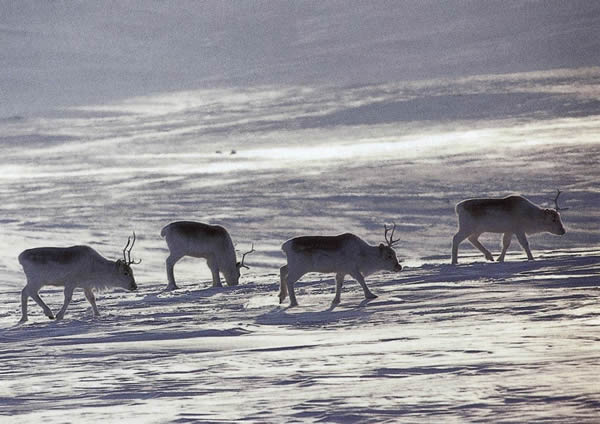- Peary Caribou
Taxobox
name = Peary Caribou
status = EN

image_caption =Peary Caribou
regnum =Animal ia
phylum =Chordata
classis =Mammal ia
subclassis =Theria
ordo =Artiodactyla
familia =Cervidae
subfamilia = Odocoilinae
genus = "Rangifer "
species = "R. tarandus"
subspecies = "R. tarandus pearyi"
subspecies_authority = Allen, 1902
binomial = "Rangifer tarandus pearyi"
binomial_authority =The Peary Caribou ("Rangifer tarandus pearyi") is a caribou
subspecies found in the highArctic islands ofCanada 'sNunavut and Northwest territories. They are the smallest of theNorth America n caribou, with the females weighing an average of 60 kg (132 lb) and the males 110 kg (243 lb). In length the females average 1.4 m (4.6 ft) and the males 1.7 m (5.6 ft).Like other reindeer, both the males and females have
antler s. The bulls grow their antlers from March to August and the females from June to September, and in both cases the velvet is gone by October. The coat of the caribou is white and thick in the winter. In the summer it becomes short and darker, almost slate-grey in colour. The coat is made up of hollow hair which helps to trap warmer air and insulate the caribou.The males become sexually mature after two years and the females after three years. Breeding is in the fall and depends on the female having built up sufficient fat reserves. The
gestation period last for 7 to 8 months and one calf is produced.Peary caribou feed on most of the available grasses,
Cyperaceae (sedges),lichen andmushroom s. In particular they seem to enjoy thePurple Saxifrage and in summer their muzzles become purple from the plants. Their hooves are sharp and shaped like ashovel to enable them to dig through the snow in search of food.The caribou rarely travel more than 150 km (100 miles) from their winter feeding grounds to the summer ones. They are able to outrun the
arctic wolf , their main predator, and are good swimmers. They usually travel in small groups of no more than twelve in the summer and four in the winter.The Peary caribou population has dropped from above 40,000 in
1961 to about 1,000 in2004 . During this period, the number of days with above freezing temperatures has increased significantly, resulting in ice layers in the snow pack. These ice layers hinder foraging and are the likely cause for dramatic drops in caribou population in the closing decades of the 20th century.The Peary caribou, called "tuktu" in
Inuinnaqtun /Inuktitut and written as "ᕐᑯᑦᓯᑦᑐᒥ ᑐᒃᑐ" inInuktitut syllabics , is a major food source for theInuit and was named afterRobert Peary .References
*Anand-Wheeler, Ingrid. Terrestrial Mammals of Nunavut. ISBN 1-55325-035-4
*IUCN2006|assessors=Deer Specialist Group|year=1996|id=19303|title=Rangifer tarandus ssp. pearyi|downloaded=17 June 2006 Listed as Endangered (EN A1b, C1)
* [http://www.natureserve.org/explorer/servlet/NatureServe?searchName=Rangifer+tarandus+pearyi NatureServe]
*Population size of Peary caribou in the Canadian Arctic islands. (June 2007). In UNEP/GRID-Arendal Maps and Graphics Library. Retrieved on January 27, 2008. [http://maps.grida.no/go/graphic/population-size-of-peary-caribou-in-the-canadian-arctic-islands]
#Further reading
* Larter, Nicholas C, and John A Nagy. 2001. "Variation between Snow Conditions at Peary Caribou and Muskox Feeding Sites and Elsewhere in Foraging Habitats on Banks Island in the Canadian High Arctic". "Arctic, Antarctic, and Alpine Research". 33, no. 2: 123.
* Maher, Andrew Ian. "Assessing Snow Cover and Its Relationship to Distribution of Peary Caribou in the High Arctic". Ottawa: Library and Archives Canada = Bibliothèque et Archives Canada, 2006. ISBN 0494050535
* Manning, T. H. "The Relationship of the Peary and Barren Ground Caribou". Montreal: Arctic Institute of North America] , 1960.
* Miller, F. L., E. J. Edmonds, and A. Gunn. "Foraging Behaviour of Peary Caribou in Response to Springtime Snow and Ice Conditions". [Ottawa] : Environment Canada, Canadian Wildlife Service, 1982. ISBN 0662120175
* Northwest Territories. (2001). "NWT peary caribou Rangifer tarandus pearyi. NWT species at risk fact sheets". [Yellowknife] : Northwest Territories Resources, Wildlife and Economic Development.
* Tews, Joerg, Michael A D Ferguson, and Lenore Fahrig. 2007. "Potential Net Effects of Climate Change on High Arctic Peary Caribou: Lessons from a Spatially Explicit Simulation Model". "Ecological Modelling". 207, no. 2: 85.External links
* [http://www.nwtwildlife.com/Publications/speciesatriskweb/pearycaribou.htm Peary Caribou]
Wikimedia Foundation. 2010.
